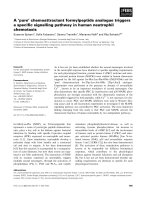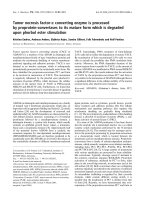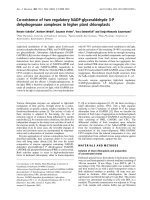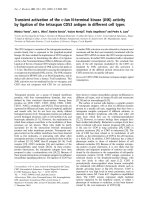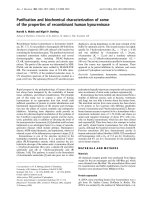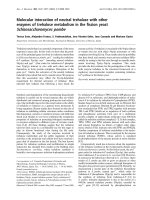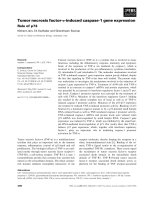Báo cáo y học: "Tumor necrosis factor-a enhances hyperbaric oxygen-induced visfatin expression via JNK pathway in human coronary arterial endothelial cells" ppt
Bạn đang xem bản rút gọn của tài liệu. Xem và tải ngay bản đầy đủ của tài liệu tại đây (1.85 MB, 14 trang )
RESEARC H Open Access
Tumor necrosis factor-a enhances hyperbaric
oxygen-induced visfatin expression via
JNK pathway in human coronary arterial
endothelial cells
Bao-Wei Wang
1,2
, Chiu-Mei Lin
3
, Gong-Jhe Wu
4,5
and Kou-Gi Shyu
2,5*
Abstract
Background: Visfatin, a adipocytokine with insulin-mimetic effect, plays a role in endothelial angiogenesis.
Hyperbaric oxygen (HBO) has been used in medical practice. However, the molecular mechanism of beneficial
effects of HBO is poorly understood. We sought to investigate the cellular and molecular mechanisms of regulation
of visfatin by HBO in human coronary arterial endothelial cells (CAECs).
Methods: Human CAECs were exposed to 2.5 atmosphere absolute (ATA) of oxygen in a hyperbaric chamber.
Western blot, real-time polymerase chain reaction, and promoter activity assay were performed. In vitro glucose
uptake and tube formation was detected.
Results: Visfatin protein (2.55-fold) and mRNA (2.53-fold) expression were significantly increased after expo sure to
2.5 ATA HBO for 4 to 6 h. Addition of SP600125 and JNK siRNA 30 m in before HBO inhibited the induction of
visfatin protein. HBO also significantly increased DNA-protein bindi ng activity of AP-1 and visfatin promoter activity.
Addition of SP600125 and TNF-a monoclonal antibody 30 min before HBO abolished the DNA-protein bindi ng
activity and visfatin promoter activity induced by HBO. HBO significantly increased secretion of TNF-a from
cultured human CAECs. Exogenous addition of TNF-a significantly increased visfatin protein expression while TNF-a
antibody and TNF- a receptor antib ody blocked the induction of visfatin protein expression induced by HBO. HBO
increased glucose uptake in hum an CAECs as HBO and visfatin siRNA and TNF-a antibody attenuated the glucose
uptake induced by HBO. HBO significantly increased the tube formation of human CAECs while visfatin siRNA, TNF-
a antibody inhibited the tube formation induced by HBO.
Conclusions: HBO activates visfatin expression in cultured human CAECs. HBO-induced visfatin is mediated by
TNF-a and at least in part through JNK pathway.
Background
Visceral fat accumulation has been shown to play crucial
roles in the development of cardiovascular disease as
well as the development of obesity-related disorders [1].
Recent evidences show that fat tissue is an active endo-
crine o rgan producing “adipocytokines” ,hormonesthat
influence a diverse array of processes including appetite
and energy balance, immunity, insulin sensitivity,
haemostasis, blood pressure, lipi d metabolism and
angiogenesis, all factors which can impact cardiovascular
disease [2]. The recently discovered adipocytokine, visfa-
tin, also known as pre-B cell colony-enhancing factor,
has been demonstrated to mimic the glucose-lowering
effect of insulin and improve insulin sensitivity [3].
However, the effects of visfatin are not restricted to glu-
cose homeostasis. Visfatin was upregulated by hypoxia
in adipocytes and in breast cancer cell through hypoxia-
inducible factor-1 [4,5]. Recently, visfatin was shown to
play a role in e ndothelial angiogenesis by activation of
fibroblast growth factor2, signal transducer and activator
* Correspondence:
2
Division of Cardiology, Shin Kong Wu Ho-Su Memorial Hospital, Taipei,
Taiwan
Full list of author information is available at the end of the article
Wang et al. Journal of Biomedical Science 2011, 18:27
/>© 2011 Wang et al; licensee BioMed Central Ltd. This is an Open Access article distributed under the terms of the Creative Commons
Attribution License ( licenses/by/2.0), which permits unrestricted use, distribution, and reproduction in
any medium, provided the original work is properly cited.
of transcription 3, and vascular endothelial growth fac-
tor and matrix metalloproteinase [6-9]. S everal factors
that could regulate visfatin s ynthesis have been identi-
fied [10,11]. Overall, visfatin is a cytokine with various
functions [12].
Hyperbaric oxygen (HBO) therapy provides a signifi-
cant increase in oxygen content in the hypoperfused tis-
sue and the elevation in oxygen content in the hypoxic
tissue induces powerful positive changes in ischemic
repair process [13]. Therefore, HBO is successfully used
for the treatment of a variety of clinical conditions [14].
HBO therapy promotes wound healing by directly enhan-
cing fibroblastic replication, collagen synthesis, and the
process of neovascularization in ischemic tissue [15].
Because of the emerging concept of coronary artery
endothelial cells (CAECs) in the progress of angiogen-
esis and no data have been presented to verify the effect
of HBO on the regulation of visfatin in human CAEC.
Therefore we hypothesize that HBO activates a proin-
flammatory response mediated through a specific tran-
scription factor, and downstream effects of this
activation increased the expression of visfatin. Therefore,
we sought to investigate the cellular and molecular
mechanisms of regulation of visfatin by HBO in human
CAECs. The induction of visfatin in human CAECs by
HBO may elucidate the mechanisms responsible for the
therapeutic effect of HBO.
Methods
Primary human coronary artery endothelial cells (CAECs)
culture
Human coronary artery endothelial cells (CAECs) were
originally obtained from PromoCell GmbH (Heidelberg,
Germany). The cells were cultured in endothelial cell
growth medium MV supplement ed w ith 1 0% fetal
bovine serum, 100 U/ml penicillin, and 100 μg/ml strep-
tomycin at 37°C in a humidified atmosphere of 5% CO
2
in air. Cells were grown to 80-90% confluence in 10
cm
2
culture dishes and were sub-cultured in the ratio of
1:2.
HBO treatment
For HBO treatment, cells were exposed to 2.5 ATA
(atmosphere absolute) of oxygen (98% oxygen plus 2%
CO
2
) in a hyperbaric chamber for 2 to 8 h at 37°C. The
small hyperbaric chamber was put in a temperature-
controlled (37°C) incubator (Additional file 1, Figure
S1). The oxygen tension was chosen based on the
human treatment protocols [16]. For the inhibition of
signal pathways, cells were pretreated with inhibitors for
30 min, and then exposed to HBO without changing
medium. SP600125 (20 μM, CALBIOCHEM
®
,San
Diego, CA) is a potent, cell-permeable, selective, and
reversible inhibitor of c-Jun N-terminal kinase (JNK).
SB203580 (3 μM, CALBIOCHEM
®
) is a highly specific,
cell permeable inhibitor of p38 kinase. PD98059 (50 μM,
CALBIOCHEM
®
) is a specific and potent inhibitor of
extracellular-signal-regulated kinase (ERK) kinase. Wort-
mannin ((5 nM, Sigma Chemical, St. Louis, MO, USA) is
a phosphatidylinositiol-3 (PI-3) kinase inhibitor.
Western blot analysis
Cells under HBO were harvested by scraping and then
centrifuged (300 × g) for 10 minutes at 4°C. The pellet
was resuspended and homogenized in a Lysis Buffer
(Promega Corp., Madison, WI, USA), centrifuging at
10,600 × g for 20 minutes. Bio-Rad Protein Assay was
used for the measure of protein content. Equal am ounts
of protein (15 μg) were loaded into a 12.5% SDS-polya-
crylamide minig el, followed by electrophoresis. Proteins
were electroblotted onto nitrocellulose. The blots were
incubated overnight in Tris-buffered saline containing
5% milk to block nonspecific binding of the antibody.
Proteins of interest were revealed with specific antibo-
dies as indicated (1:1000 dilution) for 1 hour at room
temperature followed by incubation with a 1:5000 dilu-
tion of horseradish peroxidase-conjugated polyclonal
anti-rabbit antibody for 1 h at room temperature. The
membrane was then detected with an enhanced chemi-
luminescence detection system (ECL, Amersham, Buck-
inghamshire, England). Equal protein loa ding of the
samples was further verified by staining mouse anti-
tubulin monoclonal antibody from Santa Cruz Biotech-
nology Inc. All Western blots were quantifie d using
densitometry.
RNA isolation and reverse transcription
Total RNA was isolated from cells using the single-step
acid guanidinium thiocyanate/phenol/chloroform extrac-
tion method. Total RNA (1 μg) was incubated with 200
U of Moloney-Murine Leukemia Virus reverse transcrip-
tase in a buffer containing a final concentration of 50
mmol/L Tris-Cl (pH 8.3), 75 mmol/L KCl, 3 mmol/
MgCl
2
, 20 U of RNase inhibitor, 1 μmol/L poly-dT oli-
gomer, and 0.5 mmol/L of ea ch dNTP in a final volume
of 20 μL. The r eaction mixture was incubated at 42°C
for 1 h and then at 9 4°C for 5 minutes to inact ivate the
enzyme. A total of 80 μL of diethyl pyrocarbonate trea-
ted water was added to the reaction mixture before sto-
rage at -70°C.
Real-time quantitative PCR
A Lightcycler (Roche Diagnostic s, Mann heim, Ger-
many) was used for real -time PCR. cDNA was diluted
1in10withnuclease-freewater.2μLofthesolution
was used for the Lightcycler SYBR -Green mastermix
(Roche Diagnostics): 0.5 μmol/L primer, 5 mmol/L mag-
nesium chloride, and 2 μL Master SYBR-Green in
Wang et al. Journal of Biomedical Science 2011, 18:27
/>Page 2 of 14
nuclease-free water in a final volume of 20 μL. The
initial denaturation phase for specific gene wa s 5 min at
95°C followed by an amplification phase as detailed
below: denaturation at 95°C for 10 sec; annealing at 63°
C for 7 sec; elongation at 72°C for 8 sec; detection at
79°C and for 45 cycles. Amplification, fluorescence
detection, and post -processing calculation were per-
formed using the Lightcycler apparatus. Individual PCR
products were analyzed for DNA sequence to confirm
the purity of the product.
Promoter activity assay
Visfatin gene was amplified with forward primer,
CCACCGACTCGTACAAG and reverse primer, GTG
AGCCAGTAGCACTC. The amplified product was
digested with MluI and BglII restriction enzymes and
ligated into pGL3-basic luciferase plasmid vector (Pro-
mega) digested with the same enzymes. Site-specific
mutations were confirmed by DNA sequencing. Plas-
mids were transfected into human CAECs using a lo w
pressure-accelerated gene gun (Bioware Technologies,
Taipei, T aiwan) essentially following the protocol from
the manufacturer. Test plasmid at 2 μg and control plas-
mid (pGL4-Renilla luciferase) 0.02 μg was co-transfected
with gene gun in each well, and then replaced by nor-
mal culture medium. Following 6 hours of HBO, cell
extracts were prepared using Dual-Luciferase Reporter
Assay System (Promega) and measured for dual lucifer-
ase activity by luminometer (Turner Designs).
Electrophoretic mobility shift assay (EMSA)
Nuclear protein concentrations from cells were deter-
mined by Bio-rad protein assay. Consensus and control
oligonucleotides (Santa Cruz Biotechnology Inc.) were
labeled by polynucleoti des kinase incorporation of
[g
32
P]-ATP. After the oligonucleotide was radiolabeled,
the nuclear extracts (4 μg of protein in 2 μl of nuclear
extract) were mixed with 20 pmol of the appropriate
[g
32
P]-ATP -labeled consensus or mutant oligo nucleo-
tide in a total volume of 20 μl for 3 0 min at room tem-
perature. The samples were then resolved on a 4%
polyacrylamide gel. Gels were dried and imaged by auto-
radio graphy. Controls were performed in each case with
mutant oligonucleotides or cold oligonucleotides to
compete with labeled sequences.
Measurement of TNF-a concentration by enzyme-linked
immunosorbent assay
Conditioned medium from h uman CAECs subjected to
HBO and those from control cells were collected for TNF-
a measurement. The le vel of TNF-a was measured by a
quantitative sandwich enzyme immunoassay t echnique
(Amersham Pharmacia Biotech, Buckinghamshire, Eng-
land). The lowest limit of TNF-a ELISA kit was 5 pg/ml.
Capillary-like network formation Assay
Capillary- like ne twork formation was performed in an
in vitro culture system. Matrigel 250 μL (BD Biosciences,
MA) was coated in a 24-well culture plate and allowed to
solidify (37°C, 1 hr). Human CAECs were cultured on a
Matrigel matrix and were exposed to 2.5 ATA of oxyg en
(98% oxygen plus 2% CO
2
) in a hyperbaric chamber for 6
hrs at 37°C. After HBO treatment, cells were placed in a
humidified incubator for 16 hrs with an atmosphere of 5%
CO
2
at 37°C. The capillary-like network formation w as
observed with a phase-contrast microscope (Nikon, Tokyo).
Migration assay
The migration activity of human CAECs was deter-
mined using the growth factor-reduced Matrigel inva-
sion system (Becton Dickinson) following the protocol
provided by the manufacturer. 5 × 10
4
cells were seeded
on top of ECMatrix gel (Chemicon International, Inc.,
Temecula, CA). Cells were then incubated at 37°C for 6
h with or without HBO. Three different phase-contrast
microscopic high-power f ields per well were photo-
graphed. The migratory cells with positive stain were
counted and the observer was blind to the experiment.
Glucose uptake in cultured human CAECs
Human CAECs were seeded on ViewPlate for 60 min
(Packard Instrument Co., Meriden , CT) at a cell density
of 5 × 10
3
cells/well in serum free medium for over-
night. Recombinant human visfatin 100 ng/ml (Adipo-
Gen, Inc., Incheon, Korea), visfatin siRNA, TNF-a
antibody, or TNF-a was added to the medium. Glucose
uptake was performed by adding 0.1 mmol/l 2-deoxy-D-
glucose and 3.33 nCi/ml 2-[1,2-
3
H]-deoxy-D-glucose for
various periods of time. Cells were washed with phos-
phate-buffered saline twice. Non-specific uptake was
performed in the presence of 10 μM cytochalasin B and
subtracted from all of the measured value. MicroScint-
20 50 μl was added and the plate was read with Top-
Count (Packard Instrument Co., Meriden, CT). The
radioactivity was counted and normalized to protein
amount measured with a protein assay kit.
Statistical analysis
The data were expressed as mean ± SD. Statistical signifi-
cance was performed with analysis of variance (GraphPad
Software Inc., San Diego, CA). Tukey-Kramer comparison
test was used for pairwise comparisons betw een multiple
groups after the ANOVA. A value of P < 0.05 was consid-
ered to denote statistical significance.
Results
HBO increases visfatin expression
To investigate the effect of HBO on the expression of
visfatin protein, different degrees o f ATA were used. As
Wang et al. Journal of Biomedical Science 2011, 18:27
/>Page 3 of 14
shown in Figure 1, the visfatin protein was significantly
induced by HBO at 1.5, 2, and 2.5 ATA for 6 h. Since
2.5 ATA pr ovided most powerful induction of visfatin
protein. The following experiments used 2.5 ATA as the
hyperbaric stimulation. The oxygen saturation measured
by Oxy-Check (HANNA Instruments, Inc., Woonsocket,
WI) and pO
2
measured by pHOx Plus C (Nova Biome-
dical, Waltham, MA) in the medium was 523% and
>800 mmHg, respectively after HBO treatment for 6 h
and 77% and 175 mmHg, respectively in the control
without HBO treatment. The levels of visfatin protein
shown by We stern blot analysis signific antly increased
at 4 and 6 h after HBO treatment (Figure 2A and 2B) as
compared to control without treatment. Although visfa-
tin protein level still maintained elevated after 8 h of
HBO treatment, the level of visfatin protein tended to
return to baseline level. Visfatin mRNA significantly
increased at 2 h after HBO treatment, increased to max-
imal at 4 h and returned to baseline level at 8 h after
HBO treatment (Figure 2C). Because visfatin protein
was maximally induce d at 6 h after HBO treatment, the
following experiments were set for HBO treatment for 6
hours. To simulate the clinical application o f HBO,
HBO was also applied intermittently and repeatedly day
by day at 1 h per day. The visfatin protein level
increased by intermittent and repeat exposure was simi-
lar to that by 6 hr HBO exposure (Additional file 2,
Figure S2)
HBO-induced visfatin protein expression in human CAECs
is mediated by JNK kinase
As shown in Figure 3A and 3B, the Western blot
demonstrated that the H BO-induced increase of visfatin
protein was significantly reduced after the addition of
SB203580, and SP600125, 30 min before HBO treat-
ment. The addition of PD98059 and wortmannin did
not inhibit the visfatin protein expression induced by
HBO.ThesefindingsimplicatedthatJNKandERK
pathways but not p38 MAP kinase and PI-3 kinase
mediated the induction of visfatin protein by HBO in
Control
15
2
25
(ATA)
HBO, 6 hr
A
Visfatin
Į-Tubulin
Control
1
.
5
2
2
.
5
(
ATA
)
t
ein level
o
ntrol)
2
3
4
B
*
**
**
Control 1.5 2 2.5 ( ATA
)
Visfatin pro
t
(fold of c
o
0
1
2
HBO
,
6 hr
Figure 1 Effect of HBO on visfatin protein expression.A,RepresentativeWesternblotforvisfatininhumanCAECstreatedwithdifferent
degrees of HBO for 6 hour. B, Quantitative analysis of visfatin protein levels (n = 4 per group). *P < 0.05 vs. control. **P < 0.001 vs. control.
Wang et al. Journal of Biomedical Science 2011, 18:27
/>Page 4 of 14
HBO, 2.5 ATA
Control 2
4
68 (hr
)
A
Į-Tubulin
Visfatin
B
r
otein level
c
ontrol)
2
3
B
**
**
*
Visfatin p
r
(fold of
c
0
1
Control
2
4
6
8
(hr)
HBO,2.5 ATA
Control
2
4
6
8
(hr)
e
vel
l
)
3
C
*
*
s
fatin mRNA l
e
f
old of contro
l
1
2
*
Vi
s
(
f
0
Control
2hr 4hr 6hr 8hr
HBO
,
2.5 ATA
Figure 2 HBO increases visfatin protein and mRNA expression in a time-dependent manner. A, Representative Western blot for visfatin in
human CAECs treated with various duration of HBO at 2.5 ATA. B, Quantitative analysis of visfatin protein levels (n = 4 per group). *P < 0.01 vs.
control. **P < 0.001 vs. control. C, Quantitative analysis of visfatin mRNA levels. The values from treated human CAECs have been normalized to
matched tubulin measurement and then expressed as a ratio of normalized values to mRNA in the control cells (n = 4 per group). *P < 0.01 vs.
control.
Wang et al. Journal of Biomedical Science 2011, 18:27
/>Page 5 of 14
HB
O
2.5 ATA , 6hr
A
n
level
r
ol)
Visfatin
B
Į-Tubulin
4
P<0.001
Visfatin protei
n
(fold of cont
r
0
1
2
3
*
*
HBO 2 5 ATA
C
HBO 2.5 ATA , 6hr
Ph h
JNK
HBO
,
2
.
5
ATA
(hr)
246
Ph
osp
h
o-
JNK
Total-JNK
Į-Tubulin
in
o
l)
s
pho-JNK prote
e
l (fold of contr
o
D
(hr)
0
1
2
3
4
*
*
**
+
+
Pho
s
lev
e
HBO
,
2.5 ATA
(hr)
2
4
6
Figure 3 HBO-induced visfatin expression in human CAECs is via JNK kinase. A, Representative Western blots for visfatin protein levels in
human CAECs subjected to HBO stimulation for 6 h in the absence or presence of inhibitors. B, Quantitative analysis of visfatin protein levels (n
= 4 per group). *P < 0.001 vs. HBO. C, Representative Western blots for phosphor-JNK and total JNK protein levels in human CAECs subjected to
HBO stimulation for 2 to 6 h in the absence or presence of inhibitor or siRNA. D, Quantitative analysis of phosphor-JNK protein levels (n = 4 per
group). *P < 0.001 vs. control. **P < 0.01 vs. control.
+
P < 0.001 vs. HBO at 4 h.
Wang et al. Journal of Biomedical Science 2011, 18:27
/>Page 6 of 14
human CAECs. Since JNK kinase inhibitor reduced the
visfatin protein expression most significantly. We then
focused on the JNK kinase pathway on the visfatin
protein expression induced by HBO. HBO at 2.5ATA
significantly increased the phosphorylation of JNK
(Figure 3C and 3D). SP600125, inhibitor of JNK kinase,
significantly attenuated the increased phosphorylation of
JNKinducedbyHBO.JNKsiRNAsignificantlyattenu-
ated the expression of phosphor-JNK induced by HBO.
The scrambled siRNA did not affect the phosphorylation
of JNK induced by HBO.
HBO-induced visfatin protein expression in human CAECs
is mediated by TNF-a
Exogenous addition of TNF-a at 300 pg/ml significantly
increased visfatin protein expression, similar to the level
inducedbyHBOat2.5ATA(Figure4).Exogenous
addition of angiotensin II at 10 nM also increased visfa-
tin expression but the increased level was less than that
induced by TNF- a. Exogenous addition of IL-6 at 10
μg/ml did not increase visfatin expression. As shown in
Figure 5A, HBO at 2.5 ATA significantly began to
increase the TNF-a secretion from human CAECs at
2 h after HBO stimulation and remained elevated for 6 h
and then returned to basel ine level after 8 h. The HBO-
induced vifatin protein expression was significantly atte-
nuated by the addition of TNF-a antibody (5 μg/mL) or
TNF-a receptor antibody (5 μg/mL). Addit ion of control
IgG did not abolish the induction of visfatin protein by
HBO. Exogenous addition of TNF-a at 300 pg/ml also
induced the visfatin protein expression (Figure 5B and
5C). These data indicate that TNF-a medi ates the induc-
tion of visfatin protein expression by HBO. JNK siRNA
but not control siRNA significantly inhibited the visfatin
expression induced by TNF-a
HBO increases AP1-binding activity and visfatin promoter
activity
Treatment of HBO for 2 h to 6 h signifi cantly increased
the DNA-protein binding activity of AP-1 (Figure 6A).
An excess of unlabeled AP-1 oligonucleotide competed
with the probe for binding AP-1 protein, whereas an oli-
gonucleotide containing a 2-bp substitution in the AP-1
binding site did not compete for binding. Addition of
SP600125 and TNF-a monoclonal antibody 30 min
before HBO stimulation abolished the DNA-protein
binding activity induced by HBO. Exogenous addition of
TNF-a significantly increased the DNA-protein binding
activity. To study whether the visfatin expression
induced by HBO is regulated at the transcriptional level,
we cloned the promoter region of human visfatin
(-889~+16), and constructed a luciferase reporter plas-
mid (pGL3-Luc). The visfatin promoter construct con-
tains AP-1, HIF-1a, and Stat-4 binding sites. As shown
in Figure 6B and 6C, transient transfection experiment
in human CAECs using this reporter gene revealed that
HBO for 6 h significantly induced visfatin promoter
activation. This result indicates that visfatin expression
is induced at transcriptional level by HBO. When the
AP-1 binding sites were mutated, the increased promo-
ter activity induced by HBO was abolished. Moreover,
addition of SP600125 and TNF-a antibody caused an
inhibition of transcription. The increased promoter
activity induced by exogenous addition of TNF-a was
similar to that induced by HBO at 2.5 ATA. These
results suggested that AP-1 bindi ng site in the v isfatin
promoter is essential for the transcriptional regulation
by HBO and that HBO r egulates visfatin promoter via
TNF-a and JNK pathways.
Recombinant visfatin and HBO increase glucose uptake
HBO and recombinant human visfatin at 100 ng/ml sig-
nificantly increased glucose uptake at various periods of
incubation as compared to control human CAECs with-
out treatment (Figure 7). The glucose uptake in HBO-
treated cells was similar to that in exogenous addition
of visfatin and T NF-a. Addition of visfatin siRNA or
TNF-a antibody before HBO treatment attenuated the
glucose uptake to baseline levels.
HBO increases human CAECs tube formation and
migration
To test the effect of HBO on the function of human
CAECs, tube formation and migration activity was
examined. As shown in Figure 8, HBO for 6 h signifi-
cantly increased the tube formation of human CAECs.
Pretreatment with SP600125, TNF-a monoclonal anti-
body, and visfatin siRNA significantly blocked the induc-
tion of tube formation by HBO. The control siRNA did
not inhibit the tube formation induced by HBO. HBO
for 6 h significantly increased the migration activity of
human CAECs (Figure 9). Pretreatment wit h SP600125,
TNF-a monoclonal antibody, and visfatin siRNA signifi-
cantly blocked the induction of migration by HBO. The
control siRNA did not inhibit the migration induced by
HBO.
Discussion
In this study, we demonstrated several significant find-
ings. Firstly, HBO induces tra nsient visfatin expression in
cultured human CAECs in a time- and load-dependent
manner. Secondly, TNF-a actsasanautocrinefactorto
mediate HBO-induced visfatinproteinexpressionin
human CAECs. Thirdly, JNK kinase and AP-1 transcrip-
tion factor are involved in the signaling pathways of visfa-
tin induction by HBO. Fourthly, HBO increases tube
formation and migration activity of human CAECs. The
findings that HBO induces visfatin expression in human
Wang et al. Journal of Biomedical Science 2011, 18:27
/>Page 7 of 14
CAECs and functionally human CAECs tube formation
and migration increase by HBO may further strengthen
the effect of HBO on angiogenesis. In addition to insulin-
mimetic effect, visfatin has been shown to induce angio-
genesis via fibroblast growth factor, STAT-3 and vascular
endothelial growth factor [6-8]. Recently, Adyaet al also
reported that visfatin induces angiognesis via monocyte-
chemoattractant protein-1 in human endothelial cells
[17]. Our study confirmed the effect of angiogenesis of
visfatin on human CAECs after HBO treatment.
Visfatin is a cytokine with various functions [12].
Recently, visfatin was shown to induce inflammatory
cytokines expression in human endothelial cells and
then caus ed endothelial dysfunction [18]. However, Lim
et al. demonstrated c ardio-protective effect of v isfatin
which is capable of reducing myocardial injury when
administered at the time of myocardial reperfusion [19].
Our study demonstrated that HBO induced secretion of
TNF-a, an inflammatory cytokine, from human CAECs
and TNF-a increased visfatin expression by autocrine
mech anism because exogenous administration of TNF-a
also enhanced visfatin expression and TNF-a and TNF-a
receptor antibody attenuate d the increase of visfatin by
HBO. AP-1 is a principal transcriptional factor that is acti-
vated by TNF-a and AP-1 is a well-characterized down-
stream target of JNK. In this study, we demonstrated that
A
6hr
V
isfatin
B
v
el
Į-Tubulin
4
P<0 001
**
tin protein le
v
d of control)
1
2
3
*
P<0
.
001
**
Visfa
(fol
0
1
6
hr
Figure 4 Tumor necrosis factor-a (TNF-a) increases visfatin expression. A, Representative Western blot for visfatin in human CAECs treated
with different cytokines for 6 hour. B, Quantitative analysis of visfatin protein levels (n = 4 per group). *P < 0.05 vs. control. **P < 0.001 vs.
control.
Wang et al. Journal of Biomedical Science 2011, 18:27
/>Page 8 of 14
A
o
n (pg/ml)
*
*
*
N
F-Į concentrati
o
B
HBO, 2.5 ATA
T
N
Control
2hr 4hr 6hr 8hr
(hr)
HBO 2.5 ATA , 6hr
Visfatin
C
Į-Tubulin
e
vel
)
+
P<0.001
V
isfatin protein l
e
(fold of control
)
**
¶
V
HBO 2.5 ATA
,
6hr
Figure 5 TNF-a mediates the induction of visfatin by HBO. A, HBO in creased TNF-a secretion from human CAECs after HBO treatment. The
secreted TNF-a was measured by ELISA method (n = 4 per group). *P < 0.01 vs. control. B, Representative Western blots for visfatin protein
levels in human CAECs subjected to HBO stimulation for 6 h in the absence or presence of TNF-a, TNF-a monoclonal antibody, TNF-a receptor
(TNF-a R) antibody and control IgG. (C) Quantitative analysis of visfatin protein levels (n = 4 per group). *P < 0.001 vs. HBO.
+
P < 0.001 vs.
control.
¶
P < 0.001 vs. TNF-a.
Wang et al. Journal of Biomedical Science 2011, 18:27
/>Page 9 of 14
A
HBO, 2.5 ATAHBO, 2.5 ATA
26
4
2
A
P-1
2
2
(hr)
+
1
+
16
S
tat-4
H
IF-1Į
A
P-1
B
-889
-889
1
16
S
CAĺTG,
-832 ~ -831
H
Luc
Luc
Wild typ
e
Mutant
A
Luciferase expression level
( normalized to Renilla luciferase )
Control
HBO 6hr
C
*
Visfatin
Mutant
HBO
6hr
HBO 6hr +
SP600125
HBO 6hr +
TNF-Į Ab
*
*
P<0.01
012345
TNF-Į
P<0.01
*
Figure 6 HBO increases AP-1-binding activity and visfatin promoter activity. A, Representative EMSA showing protein binding to the AP-1
oligonucleotide in nuclear extracts of human CAECs after HBO treatment in the presence or absence of inhibitors and TNF-a antibody. Similar
results were found in another two independent experiments. Cold oligo means unlabeled AP-1 oligonucleotides. B, Constructs of visfatin
promoter gene. Positive +1 demonstrates the initiation site for the visfatin transcription. Mutant visfatin promoter indicates mutation of AP-1
binding sites in the visfatin promoter as indicated. C, Quantitative analysis of visfatin promoter activity. The luciferase activity in cell lysates was
measured and was normalized with renilla activity (n = 4 per group). *P < 0.001 vs. control.
Wang et al. Journal of Biomedical Science 2011, 18:27
/>Page 10 of 14
HBO increased AP-1 binding activity. TNF-a antibody
and SP600125 inhibited the AP-1 binding activity induced
by HBO, indicating that TNF-a and JNK pathway mediate
the increased transcriptional activity of AP-1 in the HBO
model. Furthermore, TNF-a antibody and SP600125 atte-
nuated the promoter activity of visfatin by HBO. Our data
also indicate that AP-1 binding site in the visfatin promo-
ter is essential for the transcriptional regulation by HBO
because a mutant AP-1 binding site in the visfatin promo-
ter abolished the transcriptional activity induced by HBO.
We have used three proinflammatory cytokines to sti-
mulate human CAECs. Interleukin-6 did not have any
effect on visfatin release and a ngiotensin II had partial
effect on visfatin release. TNF-a produced most pot ent
effect on visfatin release. Storka et al. have demonstrated
no effect of angiotensin II on the release of visfatin from
human umbilical vein endothelial cells, adipocytes and
skeletal muscle cells [20]. The discrepancy result may
indicate different cell types respond differently to pro-
inflammatory cytokine stimulation to release visfatin.
Endothelial progenitor cell mobilization, homing and
wound healing were enhanced by HBO through nitric
oxide pathway [21-23]. However, the direct effect of
HBO on human CAECs has not reported yet. In this
study, we investigated the direct effect of HBO on
human CAECs and demonstrated that HBO enhanced
visfatin expression. HBO may induce different genes
expression in different cell types via different sign al
pathways [24,25]. Hyperoxia with 100% oxygen has been
shown to generate reactive o xygen species and produce
vasoconstriction of coronary artery [26]. HBO is different
with hyperoxia because hyperoxia is administered with
normal baric pressure. The use of hyperbaric p ressure of
oxygen makes HBO a safe and noninvasive modality for
the treat ment of many kinds of diseases. In this study,
HBO induces tube formation of human CAECs, an
essential part for angiogenesis, indicating that HBO may
be applied for patients with refractory ischemic heart dis-
eases with non-optional therapy. In the study, HBO also
significantly increased formation of reactive oxygen spe-
cies for 2 to 8 h (Additional file 3, Figure S3). This result
may suggest that HBO for 2-8 h causes oxygen toxicity.
In the present study, a protocol of 2.5 ATA 6 h HBO
is definitely not a “treatment” protocol. In the clinical
treatment protocol, HBO is applied intermittently and
repeatedly day by day at 1 h per day. Prolonged expo-
sure to HBO causes signific antly toxicity effects to the
neurologic system as well as to any cultured cells. The
visfatin induced by HBO in our study protocol may be
caused by oxygen toxicity. In the present study, we
found that HBO for 6 h increased human CAECs migra-
tion and proliferation, an early process of angiogenesis.
p
m)
400
500
Control
HBO
HBO+TNF-Į Ab
HBO+Visfatin siRN
A
Visfatin
*
*
*
*
*
H
-Glucose (c
p
200
300
Visfatin
TNF-Į
*
#
#
*
*
#
#
*
#
#
*
*
2
4
8
hr
3
H
0
100
#
In
cubat
i
o
n
t
im
e
Figure 7 Effect of HBO and recombinant visfatin on glucose uptake in human CAECs. Glucose uptake was measured i n human CAECs
treated for 90 min with 100 ng/ml recombinant visfatin with or without siRNA, TNF-a, or TNF-a antibody (Ab). *P < 0.01 vs. control;
#
P < 0.001
vs. HBO. Data are from 4 independent experiments.
Wang et al. Journal of Biomedical Science 2011, 18:27
/>Page 11 of 14
Exogenous addition of visfatin also increased migration
of human CAECs without HBO stimulation (Additional
file 4, Figure S4). Visfatin siRNA attenuated the migra-
tion and proliferation of human CAECs induced by
HBO. MTT assay did not show significant cytotoxicity
of HBO on human CAECs as compared to control or
visfatin treatment (Additional file 4, Figure S4). The
increased visfatin induced by HBO to increase angiogen-
esis may c ounteract the oxygen toxicity by prolonged
HBO exposure.
Visfatin has been demonstrated to mimic the glucose-
lowering effect of insulin and improve insulin sensitivity
[3]. In this study, we have demonstrated that HBO
increases glucose uptake in human CAECs, similar to
the effect of visfatin. Visfat in siRNA attenuated the glu-
cose uptake by HBO. This finding indicates that visfatin
mediates the glucose uptake by HBO in human CAECs.
GlucoseuptakeincreasebyHBOmayimprovethe
energy metabolism in CAECs which may provide myo-
cardial protection and anti-ischemic effect.
Conclusions
Our study reports for the first time that HBO enhances
visfatin expression in cultured human CAECs. The
HBO-induced visfatin is mediated by TNF-a and at
least in part through JNK pathway. Visfatin increases
angiogen esis after HBO, indicating that visf atin counter-
acts the oxygen toxicity by HBO.
C
ontrol HB
O
6hr
S
P600125 + HB
O
6hr
A
100 um
TNF-ĮAb + HBO 6hr Visfatin siRNA + HBO 6hr Control siRNA + HBO 6hr
4
6
8
n
gth (mm/HPF)
B
P<0.001
0
2
HBO 6hr
Tube le
n
-+++++
*
*
*
SP600125
TNF-ĮAb
Visfatin siRNA
Sc
r
a
m
b
l
e
s
iRNA
+
+
+-
+
Figure 8 Effect of HBO on human CAECs tube formation. A, Representative image of tube formation of human CAECs. B, Quantitative tube
length measurement (n = 5). *P < 0.001 vs. HBO alone.
Wang et al. Journal of Biomedical Science 2011, 18:27
/>Page 12 of 14
Additional material
Additional file 1: Figure S1: Schematic diagram of hyperbaric
chamber in incubator.
Additional file 2: Figure S2: Effect of intermittent and repeat HBO
exposure on visfatin protein expression. HBO at 2.5 ATA was applied
1 h per day. A, Representative Western blot for visfatin in human CAECs
treated with HBO at 1 h each day for different duration. B, Quantitative
analysis of visfatin protein levels (n = 4 per group). *P < 0.05 vs. control.
**P < 0.001 vs. control.
Additional file 3: Figure S3: Effect of HBO on reactive oxygen
species (ROS) formation in human CAECs. A, Representative
microscopic image for ROS assay with (left panel) or without green
fluorescence (right panel). B, Quantitative analysis of the positive
fluorescent cells. Control group indicates normoxia group. (n = 4 per
group). *P < 0.05 vs. control. **P < 0.01 vs. control.
Additional file 4: Figure S4: Effect of recombinant visfatin on
migration and viability of human CAECs . A, Representative image of
migration of human CAECs. B, Quantitative migration activity
measurement (n = 4). *P < 0.001 vs. control. C, Quantitative analysis of
viability by MTT assay.
List of abbreviations used
AP-1: activating protein-1; CAECs: coronary artery endothelial cells; ERK:
extracellular-signal-regulated kinase; EMSA: electrophoretic mobility shift
assay; HBO: hyperbaric oxygen; JNK: c-Jun N-terminal kinase; siRNA: small
interfering RNA; TNF-α: tumor necrosis factor-α; TLR: toll-like receptor; TNF-α:
tumor necrosis factor-α.
Acknowledgements
This study was sponsored in part from National Science Council, Executive
Yuan, Taiwan.
Author details
1
School of Medicine, Fu-Jen Catholic University, New Taipei City, Taiwan.
2
Division of Cardiology, Shin Kong Wu Ho-Su Memorial Hospital, Taipei,
Control HBO 6hr SP600125 + HBO 6hr
A
TNF-ĮAb + HBO 6hr Visfatin siRNA + HBO 6hr
Control siRNA + HBO 6hr
b
er / HPF
B
300
400
P<0.001
HBO 6h
Cell num
b
+
+
+
+
+
0
100
200
*
*
*
HBO
6hr
SP600125
TNF-ĮAb
Visfatin siRNA
S
c
r
a
m
b
l
e
s
iRNA
-
+
+
+
+
+
+
+
+-
+
Figure 9 Effect of HBO on human CAECs migration. A, Representative image of migration of human CAECs. B, Quantitative migration activity
measurement (n = 4). *P < 0.001 vs. HBO alone.
Wang et al. Journal of Biomedical Science 2011, 18:27
/>Page 13 of 14
Taiwan.
3
Department of Emergency Medicien, Shin Kong Wu Ho-Su
Memorial Hospital, Taipei, Taiwan.
4
Department of Anesthesiology, Shin
Kong Wu Ho-Su Memorial Hospital, Taipei, Taiwan.
5
Graduate Institute of
Clinical Medicine, Taipei Medical University, Taipei, Taiwan.
Authors’ contributions
BWW has participated in the design of the study and has made substantial
contributions to conception and design, or acquisition of data, or analysis
and interpretation of data. CML has made substantial contributions to
conception and design, or acquisition of data, or analysis and interpretation
of data. GJW has made substantial contributions to conception and design,
or acquisition of data, or analysis and interpretation of data. KGS has
participated in the design of the study and drafted the manuscript. All
authors have read and approved the final manuscript
Competing interests
The authors declare that they have no competing interests.
Received: 5 December 2010 Accepted: 4 May 2011
Published: 4 May 2011
References
1. Matsuzawa Y: The metabolic syndrome and adipocytokines. FEBS Lett
2006, 580:2917-2921.
2. Matsuzawa Y: Therapy insight: adipocytokines in metabolic syndrome
and related cardiovascular disease. Nat Clin Pract Cardiovasc Med 2006,
3:35-42.
3. Fukuhara A, Matsuda M, Nishizawa M, Segawa K, Tanaka M, Kishimoto K,
Matsuki Y, Murakami M, Ichisaka T, Murakami H, Watanabe E, Takagi T,
Akiyoshi M, Ohtsubo T, Kihara S, Yamashita S, Makishima M, Funahashi T,
Yamanaka S, Hiramatsu R, Matsuzawa Y, Shimomura I: Visfatin: A protein
secreted by visceral fat that mimics the effects of insulin. Science 2005,
307:426-430.
4. Segawa K, Fukuhara A, Hosogai N, Mortia K, Okuno Y, Tanaka M,
Nakagawa Y, Kihara S, Funahashi T, Komuro R, Matsuda M, Shimomura I:
Visfatin in adipocytes is upregulated by hypoxia through HIF-1α-
dependent mechanism. Biochem Biophys Res Commun 2006, 349:873-882.
5. Bae SK, Kim SR, Kim JG, Kim JY, Koo TH, Jang HO, Yun I, Yoo MA, Bae MK:
Hypoxic induction of human visfatin gene is directly mediated by
hypoxia-inducible factor-1. FEBS Lett 2006, 580:4105-4113.
6. Bae YH, Bae MK, Kim SR, Lee JH, Wee HJ, Bae SK: Upregulation of
fibroblast growth factor-2 by visfatin that promotes endothelial
angiogenesis. Biochem Biophys Res Commun 2009, 379:206-211.
7. Kim JY, Bae YH, Bae MK, Kim SR, Park HJ, Wee HJ, Bae SK: Visfatin through
STAT3 activation enhances IL-6 expression that promotes endothelial
angiogenesis. Biochim Biophys Acta 2009, 1793:1759-1767.
8. Adya R, Tan BK, Punn A, Chen J, Randeva HS: Visfatin induces human
endothelial VEGF and MMP-2/9 production via MAPK and PI3K/Akt
signaling pathways: novel insights into visfatin-induced angiogenesis.
Cardiovasc Res 2008, 78:356-365.
9. Kim SR, Bae SK, Choi KS, Park SY, Jun HO, Lee JY, Jang HO, Yun H, Yoon KH,
Kim YJ, Yoo MA, Kim KW, Bae MK: Visfatin promotes angiogenesis by
activation of extracellular signal-regulated kinase 1/2. Biochem Biophys
Res Commun 2007, 357:150-156.
10. Kralisch S, Klein J, Lossner U Bluher M, Paschke R, Stumvoll M, Fasshauer M:
Hormonal regulation of the novel adipocytokine visfatin in 3T3-L1
adipocytes. J Endocrinol 2005, 185:R1-R8.
11. Kralisch S, Klein J, Lossner U, Bluher M, Paschke R, Stumvoll M, Fasshauer M:
Interleukin-6 is a negative regulator of visfatin gene expression in 3T3-
L1 adipocytes. Am J Physiol Endocrinol Metab 2005, 289:E586-90.
12. Pilz S, Mangge H, Obermayer-Pietsch B, Marz W: Visfatin/pre-B-cell colony-
enhancing factor: A protein with various suggested functions. J
Endocrinol Invest 2007, 30:138-144.
13. Gill AL, Bell CAN: Hyperbaric oxygen in uses, mechanisms of action and
outcomes. Q J Med 2004, 97:385-395.
14. Mayer R, Hamilton-Farrell MR, van der Kleij AJ, Schmutz J, Granstrom G,
Sicko Z, Melamed Y, Carl UM, Hartmann KA, Jansen EC, Ditri L, Sminia P:
Hyperbaric oxygen and radiotherapy. Strahlenther Onkol 2005,
181:113-123.
15. LaVan FB, Hunt TK: Oxygen and wound healing. Clinics in Plastic Surg 1990,
17:463-472.
16. Bouachour G, Cronier P, Gouello JP, Toulemonde JL, Talha A, Alquier P:
Hyperbaric oxygen therapy in the management of crush injuries: a
randomized double-blind placebo-controlled clinical trial. J Trauma 1996,
41:333-339.
17. Adya R, Tan BK, Chen J, Randeva HS: Pre-B cell colony enhancing factor
(PBEF)/visfatin induces secretion of MCP-1 in human endothelial cells:
Role in visfatin-induced angiogenesis. Atherosclerosis 2009, 205:113-119.
18. Lee WJ, Wu CS, Lin H, Lee IT, Wu CM, Tseng JJ, Chou MM, Sheu WHH:
Visfatin-induced expression of inflammatory mediators in human
endothelial cells through the NF-κB pathway. Int J Obesity 2009,
33:465-472.
19. Lim SY, Davidon SM, Paramanathan AJ, Smith CCT, Yellon DM,
Hausenloy DJ: The novel adipocytokine visfatin exerts direct
cardioprotective effects. J Cell Mol Med 2008, 12:1395-1403.
20. Storka A, Vojtassakova E, Mueller M, Kapiotis S, Haider DG, Jungbauer A,
Wolzt M: Angiotensin inhibition stimulates PPARγ and the release of
visfatin. Eur J Clin Invest 2008, 38:820-826.
21. Thom SR, Bhopale VM, Velazquez OC, Goldstein LJ, Thom LH, Buerk DG:
Stem cell mobilization by hyperbaric oxygen. Am J Physiol Heart Circ
Physiol 2006, 290:H1378-H1386.
22. Goldstein LJ, Gallagher KA, Bauer SM, Bauer RJ, Baireddy V, Liu ZJ, Buerk DG,
Thom SR, Velazquez OC: Endothelial progenitor cell release into
circulation is triggered by hyperoxia-induced increases in bone marrow
nitric oxide. Stem Cells 2006, 24:2309-2318.
23. Gaallagher KA, Liu ZJ, Xiao M, Chen H, Goldstein LJ, Buerk DG, Nedeau A,
Thom SR, Velazquez OC: Diabetic impairments in NO-mediated
endothelial progenitor cell mobilization and homing are reversed by
hypoxia and SDF-1α. J Clin Invest 2007, 117:1249-1259.
24. Shyu KG, Wang BW, Chang H: Hyperbaric oxygen activates discoidin
domain receptor 2 via tumor necrosis factor-alpha and the p38 MAPK
pathway to increase vascular smooth muscle cell migration through
matrix metalloproteinase 2. Clin Sci 2009, 116:575-583.
25. Lee CC, Chen SC, Tsai SC, Wang BW, Liu YC, Lee HM, Shyu KG: Hyperbaric
oxygen induces VEGF expression through ERK, JNK and c-Jun/AP-1
activation in human umbilical vein endothelial cells. J Biomed Sci 2006,
13:143-156.
26. Moradkhan R, Sinoway LI: Revisiting the role of oxygen therapy in cardiac
patients. J Am Coll Cardiol 2010, 56:1013-1016.
doi:10.1186/1423-0127-18-27
Cite this article as: Wang et al.: Tumor necrosis factor-a enhances
hyperbaric oxygen-induced visfatin expression via JNK pathway in
human coronary arterial endothelial cells. Journal of Biomedical Science
2011 18:27.
Submit your next manuscript to BioMed Central
and take full advantage of:
• Convenient online submission
• Thorough peer review
• No space constraints or color figure charges
• Immediate publication on acceptance
• Inclusion in PubMed, CAS, Scopus and Google Scholar
• Research which is freely available for redistribution
Submit your manuscript at
www.biomedcentral.com/submit
Wang et al. Journal of Biomedical Science 2011, 18:27
/>Page 14 of 14
